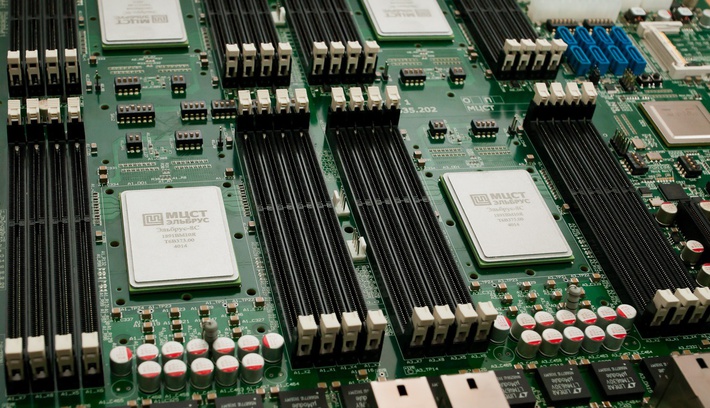Фото дня! Первая инженерная партия «Эльбрус-8С» и южного моста «КПИ-2» готовы к тестированию!
8-ядерный микропроцессор «Эльбрус-8С» создан компанией «МЦСТ» по технологическому процессу 28-нм. Он содержит 8 универсальных процессорных ядер с архитектурой «Эльбрус» третьего поколения. Кажде ядро располагает кэш-памятью 2 уровня 512 Кб. Кэш-память 3 уровня 16 Мб является общей для всех ядер. Микропроцессор содержит встроенный 4-канальный контроллер памяти типа DDR3−1600. 3 высокоскоростных дуплексных каналов LVDS с пропускной способностью 8 Гб/сек в каждую сторону для организации 4-процессорных систем на одной материнской плате. Частота микропроцессора 1,3 ГГц. Производительность 249,6 Гфлопс на 32-разрядных числах с плавающей точкой. Микропроцессор совместим с новым южным мостом «КПИ-2»
Другие публикации по теме
 «Бештау» запустил на Дону производство микропроцессоров
ГК «Бештау» объявила о начале производства микропроцессоро... часть поставляться в пределах страны», — отметил он.
«Бештау» запустил на Дону производство микропроцессоров
ГК «Бештау» объявила о начале производства микропроцессоро... часть поставляться в пределах страны», — отметил он. На базе НПФ «Моссар» в Марксе открылось новое контрактное производство электронных модулей
На базе НПФ «Моссар» в Марксе открылось новое контрак...выступил один из крупнейших российских производителей IT-оборудования.
На базе НПФ «Моссар» в Марксе открылось новое контрактное производство электронных модулей
На базе НПФ «Моссар» в Марксе открылось новое контрак...выступил один из крупнейших российских производителей IT-оборудования. Ростех создал замену импортным устройствам для бесконтактной оплаты
Компании «Азимут» (входит в Ростех) и ООО «...ования Центробанка и национальной платежной системы «Мир».
Ростех создал замену импортным устройствам для бесконтактной оплаты
Компании «Азимут» (входит в Ростех) и ООО «...ования Центробанка и национальной платежной системы «Мир».
Поделись позитивом в своих соцсетях


15.11.1418:09:55
15.11.1418:32:52
16.11.1422:05:55